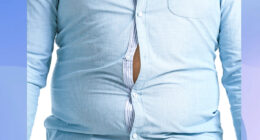

Styling: Holly Elgeti. Make-up: Nicky Weir using Hourglass Beauty. Hair: Alex Szabo at Carol Hayes using T3 Haircare. Shirt, Lisou. Earrings, Missoma. Trousers, Marella. Rings, Daisy Jewellery, Pilgrim.
The 1990s was an interesting decade. They were my teenage years, I learned to drive, had my first boyfriend and started experimenting with what kind of adult I might become.
Culturally, I remember this as an era when young women were encouraged to believe they could do anything and have it all. We were told that feminist battles had been waged and won and that we now lived in a world where young men and women could believe in equality between the sexes.
A generation of female celebrities were dubbed ‘ladettes’ for their ability to sink pints and stay out late with their male counterparts. We were told we could wear lipstick and sleep with whoever we wanted.
But as much as we thought we had agency, I’m not sure we really did. This was also a decade when Pamela Anderson, who in Baywatch displayed pneumatic breasts in a red swimsuit, was the male pin-up of choice. It was an era when I wore a Playboy T-shirt without questioning the morality of making myself a walking billboard for a pornographic magazine when I hadn’t yet lost my virginity.
Female TV presenters posed in their underwear on the cover of ‘lads’ mags’. These same magazines would run polls to determine which readers had the ‘hottest’ girlfriends.
The subject of whether Britney Spears had had sex yet became a matter of global debate. Woody Allen kept making acclaimed movies despite being accused of sexual molestation by his adoptive seven-year-old daughter (Allen vehemently denied the allegations). And we all know what Harvey Weinstein was doing in the 90s: in 2017, he was accused by dozens of women of bullying and sexual harassment.
READ RELATED: Elizabeth Day: The love cheat who got me in a flap
But living through the 90s, I didn’t think to question the contradictions I was being fed. Partly because I was still young myself; still trying to forge my own identity and get good exam results. I don’t once remember being angry at the sexist double standards of the age. I just accepted it as how the world was: women could have it all, but preferably they needed to be hot while doing it and not complain if a man came on to them.
Somewhere along the way, I ingested the message that we shouldn’t push our luck by being demanding or unpleasant when men had been kind enough to let us out into the workplace. If we felt uncomfortable or harassed, it was our fault.
It’s only over the past few years that I’ve reassessed the 90s and my own complicity. First there was the #MeToo movement, when I – like many other women – realised that the sexist insults and minor assaults I’d put up with weren’t actually acceptable. It turned out that harassment was not a rent you had to pay to occupy a space marked ‘female’.
Lately, a spate of excellent documentaries has made me look at things I once took for granted. Framing Britney Spears, a film made by The New York Times, brought home to me how outrageously she’d been treated. And it was while watching the miniseries Allen vs Farrow that I heard for the first time Dylan Farrow’s account of the sexual abuse allegation she made as a child against her adoptive father, Woody Allen. (He continues to deny any wrongdoing, describing the documentary as a ‘hatchet job riddled with falsehoods’.) Why had I never heard Dylan’s account before? Because I hadn’t sought it out. Because I was being fed a different story.
I feel pathetic that it has taken me so long to understand what was going on from the other side. I can blame it on age, on naivety, on not wanting to kick up a fuss. But it shouldn’t have taken me more than 20 years. Hopefully, our next generation of girls will be more enlightened than I was.
This week I’m…
Source: Elizabeth Day for You Magazine





